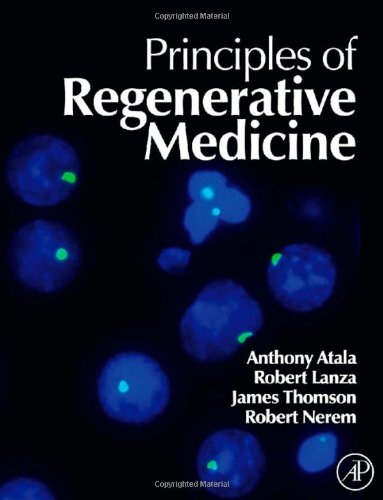

Most ebook files are in PDF format, so you can easily read them using various software such as Foxit Reader or directly on the Google Chrome browser.
Some ebook files are released by publishers in other formats such as .awz, .mobi, .epub, .fb2, etc. You may need to install specific software to read these formats on mobile/PC, such as Calibre.
Please read the tutorial at this link: https://ebookbell.com/faq
We offer FREE conversion to the popular formats you request; however, this may take some time. Therefore, right after payment, please email us, and we will try to provide the service as quickly as possible.
For some exceptional file formats or broken links (if any), please refrain from opening any disputes. Instead, email us first, and we will try to assist within a maximum of 6 hours.
EbookBell Team

4.1
90 reviews
ISBN 10: 0123694108
ISBN 13: 978-0123694102
Author: Anthony Atala, Robert Lanza, Robert Nerem, James Thomson
Chapter 1 Current and Future Perspectives of Regenerative Medicine
Chapter 2 Fundamentals of Cell-Based Therapies
Chapter 3 Stem Cell Research
Chapter 4 Molecular Organization of Cells
Chapter 5 Cell–ECM Interactions in Repair and Regeneration
Chapter 6 Developmental Mechanisms of Regeneration
Chapter 7 The Molecular Basis of Pluripotency in Principles of Regenerative Medicine
Chapter 8 How Do Cells Change Their Phenotype
Chapter 9 Somatic Cloning and Epigenetic Reprogramming in Mammals
Chapter 10 Transgenic Cloned Goats and Cows for the Production of Therapeutic Proteins
Chapter 11 Genetic Approaches in Human Embryonic Stem Cells and Their Derivatives
Chapter 12 Embryonic Stem Cells: Derivation and Properties
Chapter 13 Stem Cells Derived from Amniotic Fluid and Placenta
Chapter 14 Stem Cells Derived from Cord Blood
Chapter 15 Multipotent Adult Progenitor Cells
Chapter 16 Bone Marrow Stem Cells: Properties and Pluripotency
Chapter 17 Hematopoietic Stem Cell Properties, Markers, and Therapeutics
Chapter 18 Neural Stem Cells
Chapter 19 Mesenchymal Stem Cells
Chapter 20 Hepatic Stem Cells: Lineage Biology and Pluripotency
Chapter 21 Skeletal Muscle Stem Cells
Chapter 22 Islet Cell Therapy and Pancreatic Stem Cells
Chapter 23 Regenerative Medicine for Diseases of the Retina
Chapter 24 Peripheral Blood Stem Cells
Chapter 25 Prospects of Somatic Cell Nuclear Transfer-derived Embryonic Stem Cells in Regenerative Medicine
Chapter 26 Somatic Cells: Growth and Expansion Potential of T Lymphocytes
Chapter 27 Mechanical Determinants of Tissue Development
Chapter 28 Morphogenesis and Morphogenetic Proteins
Chapter 29 Physical Stress as a Factor in Tissue Growth and Remodeling
Chapter 30 Engineering Cellular Microenvironments
Chapter 31 Applications of Nanotechnology
Chapter 32 GeneChips in Regenerative Medicine
Chapter 33 Design Principles in Biomaterials and Scaffolds
Chapter 34 Naturally Occurring Scaffold Materials
Chapter 35 Synthetic Polymers
Chapter 36 Hybrid, Composite, and Complex Biomaterials for Scaffolds
Chapter 37 Surface Modification of Biomaterials
Chapter 38 Cell–Substrate Interactions
Chapter 39 Histogenesis in Three-Dimensional Scaffolds
Chapter 40 Biocompatibility and Bioresponse to Biomaterials
Chapter 41 Essential Elements of Wound Healing
Chapter 42 Proteins Controlled with Precision at Organic, Polymeric, and Biopolymer Interfaces for Tissue Engineering and Regenerative Medicine
Chapter 43 Biomineralization and Bone Regeneration
Chapter 44 Blood Substitutes: Reverse Evolution from Oxygen Carrying to Non-Oxygen Carrying Plasma Expanders
Chapter 45 Articular Cartilage
Chapter 46 Implantation of Myogenic Cells in Skeletal Muscles
Chapter 47 Islet Cell Transplantation
Chapter 48 Cell-Based Repair for Cardiovascular Regeneration and Neovascularization: What, Why, How, and Where Are We Going in the Next 5–10 Years?
Chapter 49 Retinal Pigment Epithelium Derived from Embryonic Stem Cells
Chapter 50 Cell Therapies for Bone Regeneration
Chapter 51 Cell-Based Therapies for Musculoskeletal Repair
Chapter 52 Hepatocyte Transplantation
Chapter 53 Bioartificial Livers
Chapter 54 Neuronal Transplantation for Stroke
Chapter 55 Cell-Based Drug Delivery
Chapter 56 Fetal Tissues
Chapter 57 Engineering of Large Diameter Vessels
Chapter 58 Engineering of Small Diameter Vessels
Chapter 59 Vascular Assembly in Engineered and Natural Tissues
Chapter 60 Cardiac Tissue
Chapter 61 Regenerative Medicine in the Cornea
Chapter 62 Alimentary Tract
Chapter 63 Liver Cell-Based Therapy – Bioreactors as Enabling Technology
Chapter 64 Intracorporeal Kidney Support
Chapter 65 The Kidney
Chapter 66 Genitourinary System
Chapter 67 Tissue Engineering of the Reproductive System
Chapter 68 Therapeutic Opportunities for Bone Grafting
Chapter 69 Cartilage Tissue Engineering
Chapter 70 Phalanges and Small Joints
Chapter 71 Functional Tissue Engineering of Ligament and Tendon Injuries
Chapter 72 Tissue Therapy: Implications of Regenerative Medicine for Skeletal Muscle
Chapter 73 Tissue Therapy: Central Nervous System
Chapter 74 Peripheral Nerve Regeneration
Chapter 75 Dental Tissue Engineering
Chapter 76 Innovative Regenerative Medicine Approaches to Skin Cell-Based Therapy for Patients with Burn Injuries
Chapter 77 Military Needs and Solutions in Regenerative Medicine
Chapter 78 Ethical Considerations
Chapter 79 To Make is to Know: The Ethical Issues in Human Tissue Engineering
Chapter 80 US Stem Cell Research Policy
Chapter 81 Overview of FDA Regulatory Process
Chapter 82 Current Issues in US Patent Law
principles of regenerative medicine
regenerative principles
introduction to regenerative medicine
a brief definition of regenerative medicine
regenerative medicine principles paradigms and practice
Tags: Anthony Atala, Robert Lanza, Robert Nerem, Principles